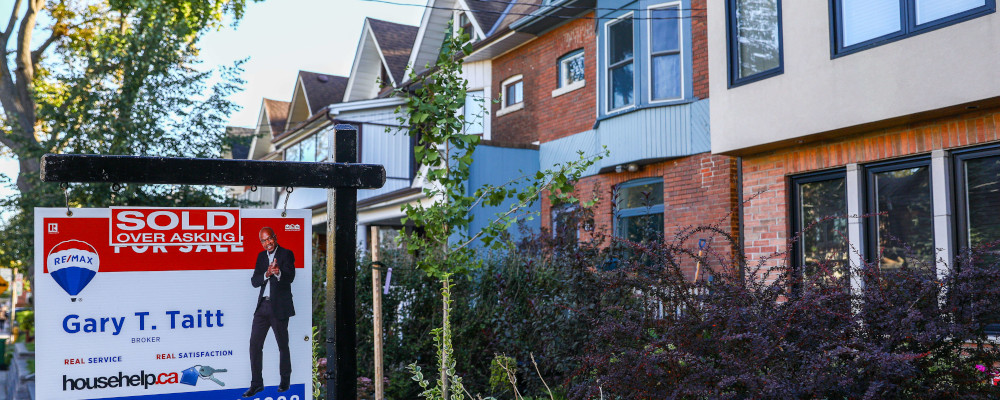I’ll be the first person to tell you that housing prices in Canada are too high. It’s one of the biggest challenges facing the country. If we fail to meaningfully accelerate housing construction very soon, we risk having a generation permanently priced out of the housing market.
Recently released Census data showed that roommates are the fastest growing type of household in Canada. Get used to it. If you’re hoping that the Bank of Canada will crush housing prices, I urge you to reconsider. Because if housing prices fall too far and too fast, we might have bigger problems on our hands.
Before I go any further, I don’t actually think we’re heading for a major decrease in housing prices in Toronto or Vancouver. It’s certainly possible that suburban areas that benefited from the COVID-era land rush will experience some real pain. But even if we rolled back five years of price appreciation, Canadian housing will remain expensive. And that’s not even accounting for the fact that rising interest rates increase the cost of borrowing. So even if prices go down, mortgage payments (and rents) can still go up.
It’s hard to see how housing prices could fall durably in the GTA or Lower Mainland in the near term. They’re not building new land in Toronto and Vancouver, and there’s no reason to believe that demand to live in the two cities will decrease. We can certainly wrestle down prices over time by allowing more density. But that won’t happen overnight.
It’s true that there are other cities in Canada with much to offer.However, if you want to live in Canada in a relatively big city without winter, Vancouver is your one option. If you want to live in a major global (anglophone) city, your option is Toronto. If you’re fluently bilingual, you may be able to find a comparable job in Montreal for less money (but lower housing prices). Ontario and Quebec account for more than half of the population of the country. There are only so many cities to choose from if you want to live an urban lifestyle (fewer still if you’re not bilingual). I spent nearly a decade working on the Prairies, so I’ve seen this first hand. But unless major parts of the GTA economy relocate to Saskatoon or Calgary (or if fully remote work remains widespread), a lot of people are going to have no choice but to live in the GTA.Then there’s the small matter of family. Not everyone is willing to relocate to the other side of the continent. Calgary might only be a three-hour-and-forty-five-minute flight away from Toronto, but that’s a hard weekend trip. Especially if you’re visiting family who doesn’t happen to live right in Mississauga or along the Union Pearson Express route. Trust me, it’s hard.
Of course, it’s conceivable that we could see a big decline in housing prices while affordability worsens. I don’t think this scenario is likely. But I also think it’s the single most likely scenario involving a large, sudden decline in housing prices. It sounds counterintuitive until you think about the role that housing plays in the economy.
Most people own homes, and it is the biggest asset most people own—by far. In a country with expensive housing, even more so. How much money people have access to and are willing to spend is related to the value of their homes. When prices are going up, people feel better about taking a vacation or going out for dinner. The house is building your retirement wealth. No reason not to have that steak or fly to Hawaii. Until, of course, your home all of a sudden becomes a drag on your household wealth. And worse, in the short term, it gets harder to tap into your home equity. Then maybe you skip the steak and drive to your parents’ place for the weekend. That’s just prudent, after all.
Here’s the problem. If enough people decide all at once that it’s time to hunker down and save money, a lot of businesses will suffer. That’s not necessarily a big problem. Economic fluctuations happen, and we adapt. Where it becomes a problem is when you’ve got a highly indebted country. If business closures and layoffs mean more people start to miss mortgage payments, you’ve got a slightly bigger problem. Now layer on higher interest rates, and you can see how this might escalate.
If all this sounds familiar, it should. The United States experienced a similar (but far more complex) issue in 2008. While the causes of the Global Financial Crisis were complex, economists Atif Mian and Amir Sufi in their book House of Debt laid out a useful framework for how falling home prices combined with high levels of personal debt can spill over into the broader economy. They describe their “levered losses framework” as follows.
- The economy consists of borrowers and savers. In the context of housing markets, mortgage holders are the borrowers. Since lenders (banks) have a senior claim on the debt, they can foreclose if borrowers cannot pay.
- A shock to the economy can cause highly indebted borrowers to stop spending and increase savings. Since spending by borrowers is more sensitive to housing wealth than savers, the concentration of losses among borrowers can magnify the decline in economic activity.
This sounds very simple, but it has profound implications. Borrowers, who tend to have lower net worth than savers, are more impacted by home price decreases (particularly since savers can foreclose, recuperating assets). High levels of debt combined with a sharp reduction in a household’s assets mean they will spend less money on goods and services as they attempt to build up savings or at the very least keep paying the mortgage.
This isn’t a problem if we’re talking about a single household. But when multiplied across the economy, it can lead to a decrease in aggregate economic activity (e.g. a recession). In the case of a sharp decrease in housing prices in a country that has high levels of personal debt, it can be much worse than a garden variety recession.
It’s easy for people locked out of the housing market to look at homeowners who have seen the value of their homes double or triple and think maybe it wouldn’t be so bad if they took a haircut. Or maybe something more than a haircut. It’s not their fault that housing prices have gone up, but the schadenfreude would be understandable. But it would likely be fleeting since many of the people currently locked out of the housing market would themselves get wiped out by a deep recession. If housing prices get cut in half but you don’t have a paycheque anymore, it’s hard to say that housing is affordable.
Fortunately, this seems like an unlikely scenario. The GTA and Lower Mainland aren’t the U.S. Sunbelt, not to mention the fact that our financial institutions could likely withstand a deep recession, preventing a financial crisis that would compound the downturn. There’s no excess of speculative housing developments and no obvious risks to our financial system. So housing prices probably aren’t going to plummet any time soon.
In fact, at this rate we’d need to double housing construction to keep housing prices from rising further. It seems likely that some of the excesses of the COVID-era will get flushed out (few people are rushing to move out of the cities anymore), but it’s more likely that transactions will decrease as sellers decide to wait out temporary weakness rather than that housing prices will collapse.What makes Canada’s housing challenges even stickier is that short-term price declines could help fuel higher prices in the future. There’s an old saying: the cure for high prices is high prices. High home prices make building homes more attractive to developers. If prices fall too far too fast, some projects will get shelved. This is already a concern in the GTA. Perversely, it’s possible that even a mild short-term pullback in housing prices could add to our housing supply deficiency. Yet another reason not to cheer for a crash.
None of this is to say that we shouldn’t want housing prices to go down. We need to re-balance housing markets, not crush them. A sharp downturn in prices would just compound problems by leading developers to cancel projects, preventing pent-up supply from meeting demand. But we need to be careful what we wish for. A deep recession isn’t going to fix our problems.
Recommended for You

The state of Canada’s economy halfway through 2025

‘It’s really important that we make mining fashionable again’: Ken Ash on why mining is essential to creating a happy and secure Canada

The Notebook by Theo Argitis: Trump halts trade talks, Carney’s trade-offs and John McCallum’s legacy

Lydia Perovic: The future of history looks bleak, if Toronto’s museums are any indication



